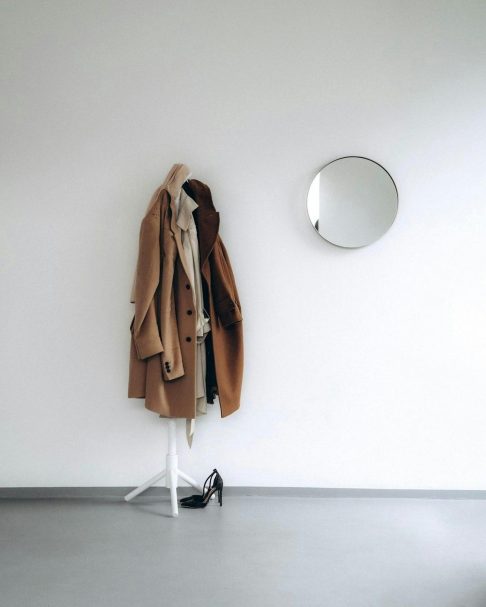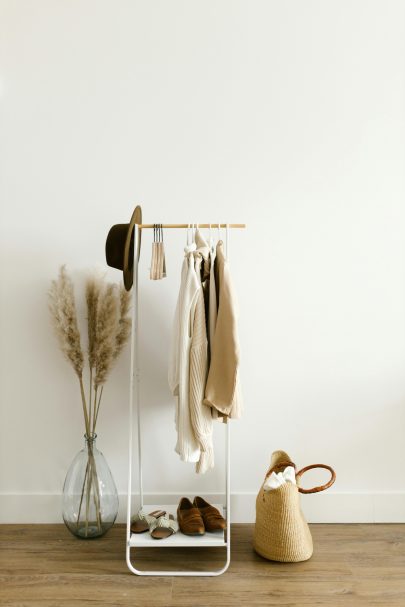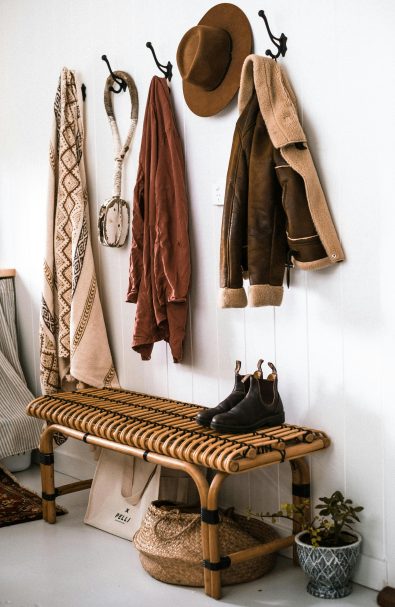A coat rack can look boutique and intentional, or it can look like a crowded lost-property corner. The difference is in scale, placement and restraint. Here is how to fold one into your space so it adds polish and order, not visual noise.

Pexels
Choose the right silhouette for the room
Start with proportion. A slender tripod suits a narrow hallway, a turned timber column warms a period entrance, and a sleek metal stand complements modern flats. If your ceiling is low, avoid tall finials that exaggerate height. If your doorway is grand, a slightly weightier base looks balanced. Aim for a rack that is visually similar to the other elements in the space, for example, match the finish to your door hardware, console handles or mirror frame so it feels like part of the family.
Edit the colour and finish
Keep to one dominant finish rather than a mix. Black, bronze and deep brown read heritage and quietly disappear behind coats. Brushed metal and cream are lighter and contemporary. Natural wood softens hard surfaces and pairs well with woven baskets or sisal runners. If the entry is already busy with pattern and artwork, choose a matte finish so the rack recedes.
Put it where it can breathe
Position the rack within easy reach of the door, but leave space for the door to swing. Give it a little air on all sides so coats can dry and you can see the floor around the base. Corners work well if the base is compact. Avoid the middle of a narrow corridor where sleeves will snag passers-by. If you have a console or bench, tuck the rack just beyond it to create a small zone that reads as a deliberate drop-spot.
Set a capacity and stick to it
Visual clutter starts with overloading. Decide how many items the rack will hold and be ruthless. As a guide, let every other hook stay free so layers hang cleanly. Rotate by season. Heavy winter gear can live in a cupboard once spring arrives, then the rack can hold lighter jackets, a dog lead and one bag. If you regularly host guests, keep a couple of hooks clear so their coats do not end up draped over chairs.

Pexels
Curate what lives on it
Treat the rack like a small display rather than storage overflow. Vary lengths for a tidy cascade, for example, a long trench, a hip-length jacket, a scarf. Keep a simple colour story so it looks intentional. Neutrals with one accent accessory is an easy win. Avoid hanging multiple bulky backpacks, helmets or shopping bags here; those belong in a utility zone or cupboard.
Add a base solution to catch drips and grit
A slim boot tray or small mat beneath the rack protects floors and anchors the vignette. Choose something that echoes your rug or door mat so it feels planned. If your rack has an umbrella ring, pair it with a discreet drip tray that fits under the holder. Empty water after rain, and rotate heavy coats so the weight is spread across the frame.
Pair it with one supporting piece
One companion item is plenty. A narrow mirror above a console, a small artwork, or a simple bench for shoes gives the area purpose without crowding it. Keep surfaces clear, for example, a single dish for keys rather than a scatter of bits and bobs. If space is tight, skip the console and hang a mirror opposite the rack to bounce light and make the entry feel larger.
Mind the sightlines
Stand at your front door and check the first view in. The rack should look tidy from that angle. Do the same from the living room so you are not staring at a sleeve overload. If you can see the back of the rack, choose one with a considered profile, for example, a simple column rather than fussy scrolls.
Keep it steady and quiet
Stability is non-negotiable. A weighted or wide base keeps things upright on busy days. Felt pads protect timber floors and stop the base from skidding on tiles. If joints loosen over time, tighten fixings and give the frame a quick wipe to remove hand oils and city dust. Small maintenance moments keep the whole scene looking crisp.
When a wall solution is better

Pexels
If your entry is extremely narrow, a short row of wall pegs or a slim rail placed higher on the wall may suit better than a stand. The same styling rules apply: keep capacity low, match finishes, and curate what hangs there. The aim is the same tidy, boutique feel without floor clutter.
A coat rack works when it feels like furniture, not a dumping ground. Match the finish to your space, give it breathing room, limit what it holds and style it with intention. Do that and you will retire the chairdrobe for good, while your doorway reads calm, collected and ready for the day.
ALSO SEE:
Featured Image: Pexels

